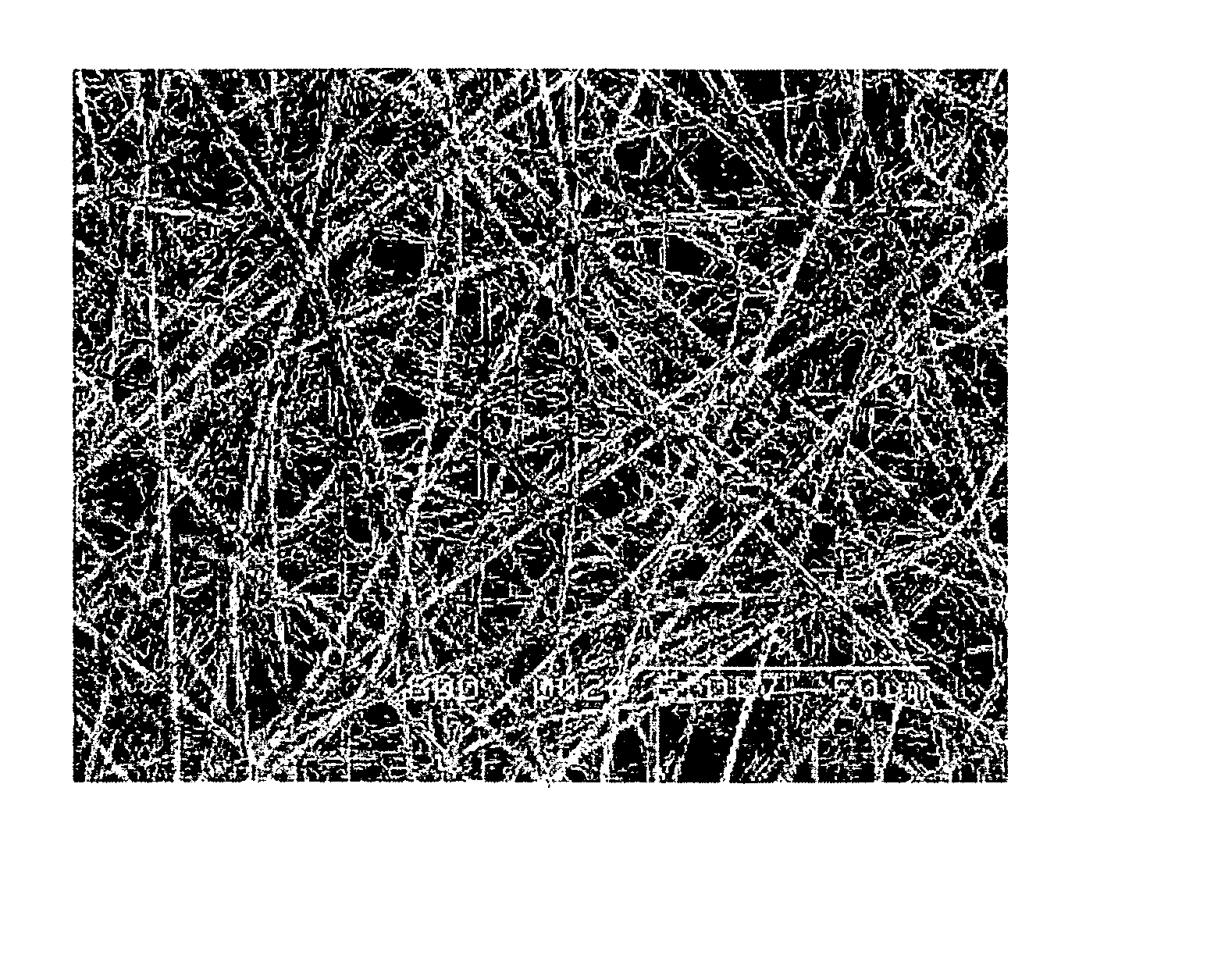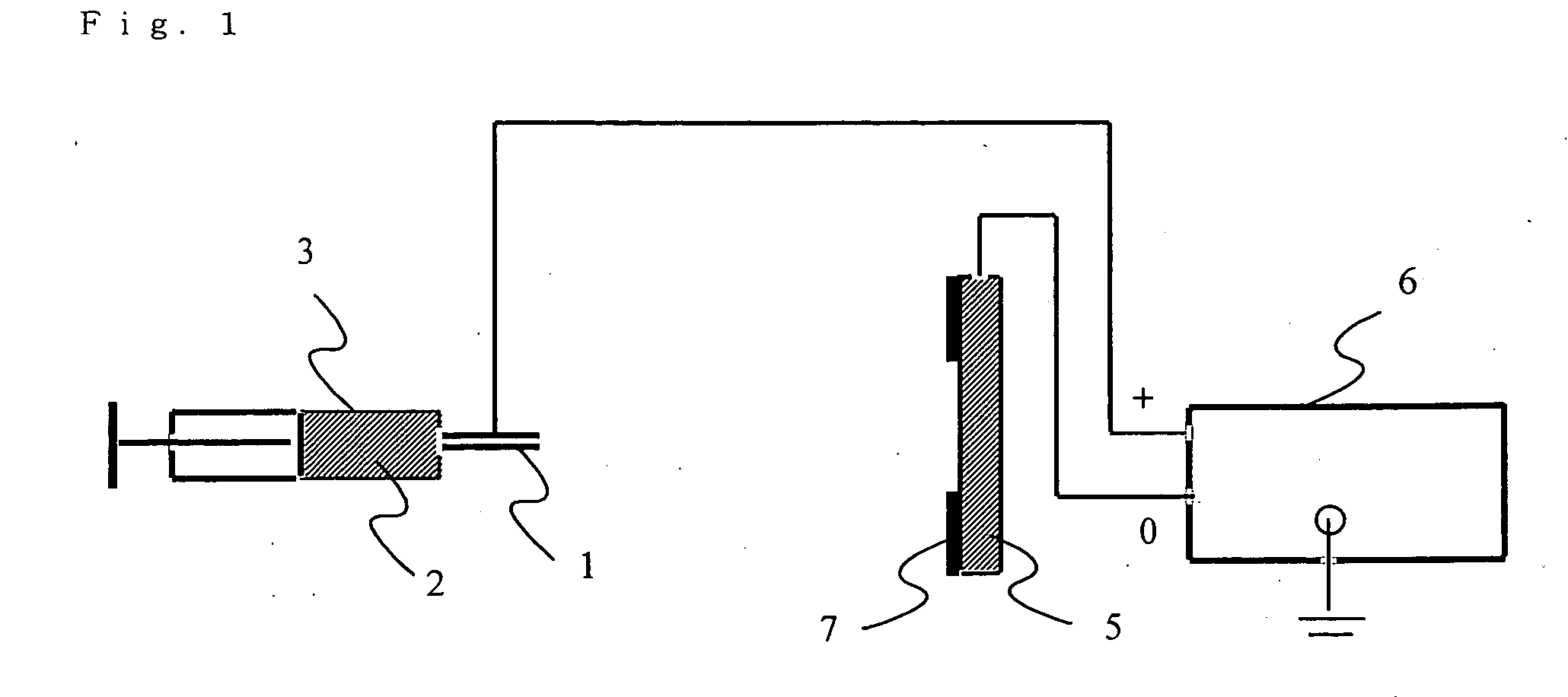Inorganic Fibers, Fiber Structure and Process for Their Production
a technology of inorganic fibers and fibers, applied in the field of inorganic fibers, can solve the problems of insufficient surface area of fibers exhibiting photocatalytic activity, inability to increase the area-to-weight ratio, and inability to produce inorganic fibers of 2 m or smaller, etc., and achieve the effect of small fiber diameter
- Summary
- Abstract
- Description
- Claims
- Application Information
AI Technical Summary
Benefits of technology
Problems solved by technology
Method used
Image
Examples
example 1
[0066] A solution was prepared containing 8 parts by weight of polycarbomethylsilane (molecular weight: 3500; Aldrich Co.), 0.1 part by weight of polyethylene glycol (molecular weight: 4 million, Wako Pure Chemical Industries, Ltd.), 83.9 parts by weight of dichloromethane (special grade, Wako Pure Chemical Industries, Ltd.) and 8 parts by weight of titanium tetrabutoxide (Wako Pure Chemical Industries, Ltd.). Next, the apparatus shown in FIG. 1 was used to discharge the solution onto a collecting electrode (5 in FIG. 1) for 10 minutes. The inner diameter of the ejection nozzle (1 in FIG. 1) was 0.5 mm, the voltage was 12 kV, and the distance from the ejection nozzle 1 to the filamentous substance-collecting electrode 5 was 15 cm. The obtained fiber structure was in the form of a nonwoven fabric.
[0067] The obtained fiber structure was allowed to stand in air at 70° C. for 100 hours, and after raising the temperature to 200° C. (temperature-elevating rate: 10° C. / min) and holding fo...
example 2
[0069] A fiber structure was formed as a nonwoven fabric by the same procedure as in Example 1, except that polyethylene oxide (molecular weight: 200,000, Aldrich Co.) was used instead of polyethylene glycol (molecular weight: 4 million, Wako Pure Chemical Industries, Ltd.) in the dope.
[0070] When the obtained fiber structure was rendered infusible and fired by the same procedure as in Example 1, the obtained fiber structure was flexible and had a mean fiber diameter of 1.0 μm, the mean diameter of depressions in the fiber surfaces was 70 nm, and the area of the depressions occupied 32% of the fiber surfaces.
[0071] The nonwoven fabric fiber structure was then shaped. When the obtained fiber structure was measured by scanning electron microscope (S-2400 by Hitachi, Ltd.), no fibers with fiber lengths of less than 100 μm were observed. A scanning electron microscope photograph of the surface of the obtained fiber structure is shown in FIG. 5.
example 3
[0072] A fiber structure was formed as a nonwoven fabric by the same procedure as in Example 1, except that a solution comprising 8 parts by weight of polycarbomethylsilane (molecular weight: 3500, Aldrich), 8 parts by weight of zirconium tetrabutoxide (80% butanol solution, Wako Pure Chemical Industries, Ltd.), 0.1 part by weight of polyethylene glycol (molecular weight: 4 million, Wako Pure Chemical Industries, Ltd.) and 181.9 parts by weight of dichloromethane (special grade, Wako Pure Chemical Industries, Ltd.) was used as the dope. The obtained fiber structure was allowed to stand in air at 90° C. for 16 hours, and after raising the temperature to 200° C. (temperature-elevating rate: 10° C. / min) and holding for 3 hours, the temperature was raised to 1000° C. at a temperature-elevating rate of 2° C. / min in a nitrogen atmosphere, and then returned to room temperature. The obtained fiber structure was flexible and had a mean fiber diameter of 0.8 μm, the mean diameter of depressio...
PUM
| Property | Measurement | Unit |
|---|---|---|
| lengths | aaaaa | aaaaa |
| diameter | aaaaa | aaaaa |
| diameter | aaaaa | aaaaa |
Abstract
Description
Claims
Application Information
 Login to View More
Login to View More - R&D
- Intellectual Property
- Life Sciences
- Materials
- Tech Scout
- Unparalleled Data Quality
- Higher Quality Content
- 60% Fewer Hallucinations
Browse by: Latest US Patents, China's latest patents, Technical Efficacy Thesaurus, Application Domain, Technology Topic, Popular Technical Reports.
© 2025 PatSnap. All rights reserved.Legal|Privacy policy|Modern Slavery Act Transparency Statement|Sitemap|About US| Contact US: help@patsnap.com



